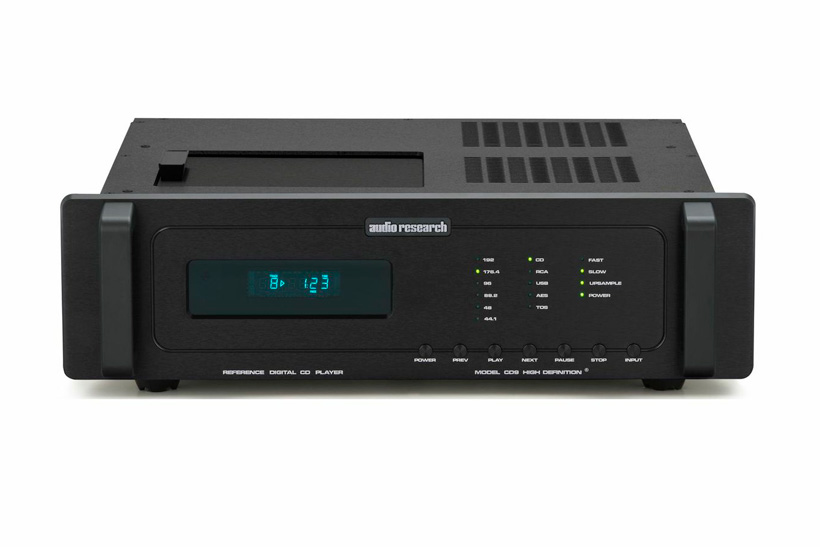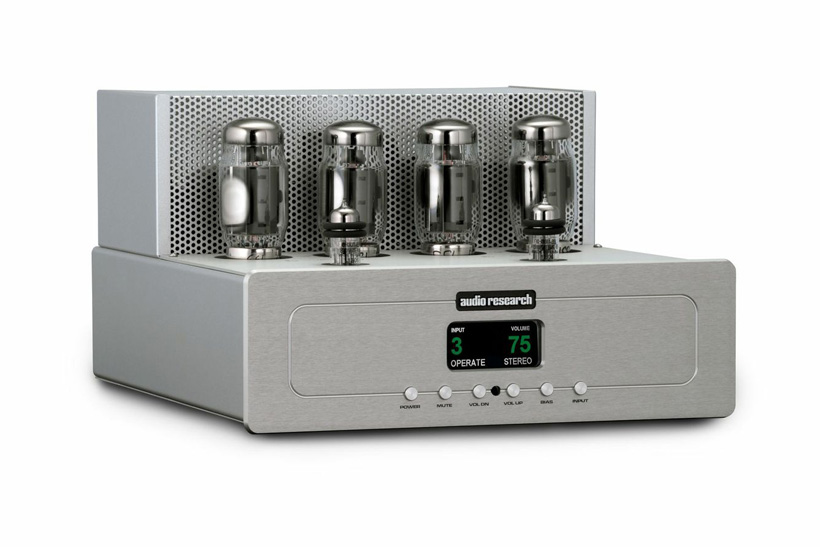Whilst I was at the High End Show 2013 in Munich, I had the opportunity to talk to David E. Gordon, managing director of sales at Audio Research. David has been involved with the company since 1989, he was also the sales manager for Jim Thiel’s loudspeaker products. Audio Research was purchased by the Italian Fine Sounds Group five years ago and is now linked with several high end brands including Sonus faber, Wadia, McIntosh and Sumiko.
RvE: What influence has the Fine Sounds takeover had on Audio Research?
DG: Well it only brought us good things, due to the fact that the Fine Sounds Group is not into making a quick profit from companies they buy, instead they invest in them, looking to the future and wanting to strengthen them. After our purchase the first thing we did was to hire our own great digital engineer, which allowed us to advance beyond two CD players and to develop products like the DAC8, DSPre (preamp/DAC), the Reference DAC, and the Reference CD9 transport/DAC (below). We were able to develop these products ourselves and did not have to rely on other companies. Wadia, also owned by Fine Sounds, has remained totally separate. We wanted to pursue our own digital path.
Additionally, we have grown our global network of distributors and are able to supply our dealers and distributors faster than before. In the US and worldwide our sales have increased every year since 2007, even with a shrinking market, because dealers are carrying fewer lines and more have chosen to sell Audio Research instead of competing lines. They appreciate that we support all of our products, including the ones that were manufactured a long time ago. In the high price segment, dealers stock Audio Research, and at a lower price point lines like PrimaLuna are popular.

We stay as traditional as ever. We shop locally for every part and we proudly use as many parts with US origin as possible. We still build every product by hand, and after testing we take the time to listen to every single product before it ships. Each product is burned in for 48 hours before our man listens to it to make sure it sounds right. I could not do his job because every day he listens repetitively, over and over, which drives some people crazy, but he has very good sonic memory. His ears prove that we can hear things that cannot be measured with the best test equipment. He can hear whether the tube dampers are positioned at the proper spot on each tube!
RvE: Tube amp circuit are so well known, are we still making improvements?
DG: Yes, tube circuits are well known but they are not all the same and we design new circuits that are sometimes simpler, with much better parts that we also design, with very tight tolerances. In the past we sometimes used parts for compensation, or we used multiple amplification stages, but we no longer need the extra circuits and we have a better sound quality as a result. A very important part of tube amps are the capacitors, and they have improved a lot compared to the past quality. They pass so much more detail that we can hear the differences when we space them from the circuit board, and in some cases whether there is printing on the outside of the capacitor. Some of our capacitors come to us blank, with a tag identifying the electrical value, and after insertion on the board we remove the identifying tag.
We do have an enormous number of spare parts for everything we ever made. We are able to service all products, even the oldest ones, except for one CD player. Our supplier ran out of CD transports and Philips does not supply these specific transports any longer. They are sold out worldwide.
RvE: How about solid-state?
DG: We develop solid-state amps as well, we have since the seventies. All of them are Class D now, but we are not using modules from other companies. We developed all of our own circuits. Our solid-state amps are not digital, they switch in the analogue domain and the signals remain analogue all the way. Class D is not “digital” in our case. We like this technology because it is very efficient and has low power consumption. Inside the product you will always find a normal analogue power supply and not a switching one, switching power supplies do not meet our standards. In the Definition series we have one integrated power amplifier, two stereo power amplifiers, one mono amplifier, and a preamp-DAC. Our CD5 is usually sold with the Definition series products.

VSi75 integrated amplifier also debuted at The HIgh End, Munich
RvE: What are the major developments in digital playback?
DG: Well, if you look at the Reference CD9 player you will notice digital inputs. Our tube DAC and tube CD player also share the same circuit in the analogue section of the circuit. We have moved on to better D/A conversion techniques thanks to our digital engineer, as I mentioned before. Of course we have asynchronous USB inputs beside the S/PDIF interfaces. My opinion is that USB is very good but there are better ways to transfer a digital signal, like streaming over wired Ethernet from a NAS drive. It sounds better, and you do not have to use computer software with drivers. From that point of view a Mac is a better choice than Windows when we use programs like Audirvana, Amarra, or Pure Music. We have had no support for DSD file transfer, but we will in the near future. Our Reference DAC has an Ethernet input, an internet tuner, and will stream wired or wirelessly with DLNA. We developed the hardware and the software to stream ourselves and we have our own App. Our specialty is developing hardware, so we have worked with outside software developers, although that may change.
RvE: Are phono stages still important?
Oh yes they are. We are designing a new preamp with a MM/MC phono stage right now. We have the LP 1, the PH 6 and PH 8, a Reference 2 Special Edition, and we just introduced the two box Reference Phono 10, our top model (below). We are conservative in the Midwest and have been careful in developing more phono stages, but playing vinyl records has increased in popularity around the world. We sell them everywhere, especially in Europe. Other important markets for us are China, Russia, Australia, and throughout Asia, except for Japan where we do not have a distributor right now.

RvE: Do you like the KT-120 tubes?
DG: Except for the 6L6 back in the early seventies we have always used the 6550 tube as our main power output valve. When the KT-120 was being developed we tried them immediately, but the first ones needed more work so we waited till the manufacturer improved them. Some of our circuits have changed a bit to give the best results with this new type of tube. They are a replacement for 6550 tubes in most of our amplifiers, as long as they are not used horizontally; we have made some amps with horizontal tubes inside. The KT-120 tube is stronger than the 6550 or KT-88, with the same sound signature as the 6550 but with higher resolution and better dynamics. We are proud of the Audio Research sound and want to maintain it with tubes or with solid-state amps.
At that point we returned to the Fine Sounds Group stand to take a look at the products on display. With the new Audio Research look the black handles have changed nto silver and as David mentions, most wives of music lovers find this an improvement. I was impressed by the number of products Audio Research has on sale these days .It’s growing in a shrinking market and although Audio Research might be an old and established company it is just as eager and fresh as anyone else and keeps a keen eye on what demanding customers want.
Author: René van Es


